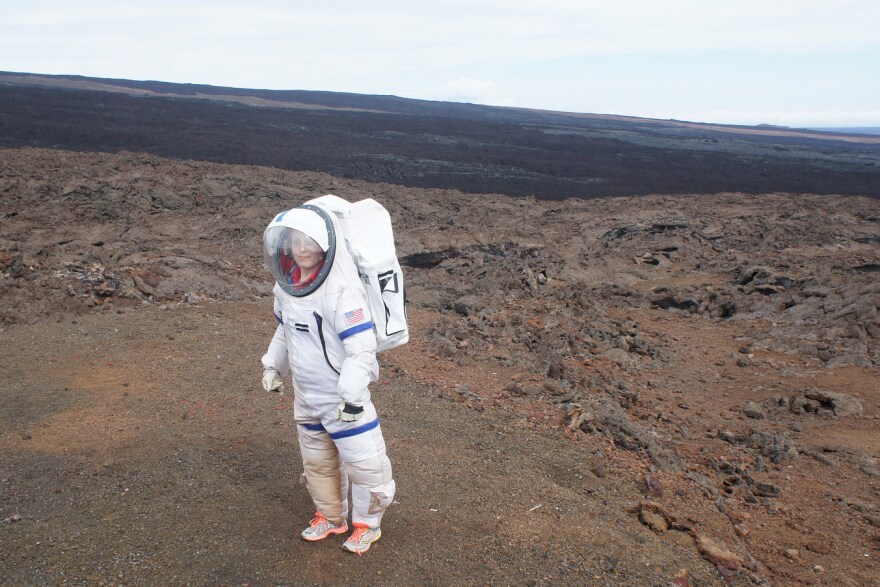It has been a year since Christiane Heinicke has had an egg. Or been in a car. Or gone outside without a spacesuit.
Since last August, the German physicist has been living with five other people in a 1,200-square-foot, solar-powered dome on the side of a Hawaiian volcano in an experiment in Mars-like living. The project, known as the Hawaii Space Exploration Analog and Simulation, or , ended Sunday.
Today, the crew is back in the town of Kailua-Kona to debrief and answer the big question: What advice would they give to future would-be inhabitants?
"Bring something to work on. Something meaningful to work on," Heinicke said in a video posted to Twitter on Sunday by the University of Hawaii, which is running the NASA-funded research project. "One of your biggest enemies is boredom. The other big enemies, of course, are the rest of the crew," she said, laughing.
The goal of HI-SEAS is to test what it would be like for people to live on Mars, and what the project designers call "team performance and cohesion" — or how a group of strangers might handle being stuck together for 12 months.
Asked what she learned about how to cope with living and working with the same five people all the time, Heinicke said emergencies play a surprising role in helping people get along.
At one point, for example, the system for gathering and treating water broke. To simulate life on Mars, the team received water and food only every two and four months, respectively. "Obviously, we need water, so we all needed to work on that as a group," Heinicke recalled.
"If you had some arguments within the group... it really helps to have an emergency to work on together, because everyone has new motivation," she said.
The study designers described the small dome where the crew lived as a "habitat," writing in a press release:
"It is an open concept design that includes common areas such as kitchen, dining, bathroom with shower, lab, exercise, and work spaces. A second floor loft spans an area of 424 square feet and includes six separate bedrooms and a half bath. In addition, a 160 square foot workshop converted from a 20 foot long steel shipping container is attached to the habitat."
Living in such close quarters is difficult. Asked whether the experience left her with any close friends, Heinicke was diplomatic. "Um, well, three of them I'm definitely going to stay in very close contact with," she said.
Hundreds of people apply from around the world to be part of HI-SEAS missions; this was the fourth one. Earlier missions have each lasted four or eight months. (Another simulation that ended in 2011 in Russia lasted 520 days.)

A committee of space experts chooses crew members they describe as "astronaut-like," and the candidate criteria include an undergraduate degree in science or engineering, at least three years of research experience or graduate study, and mental and physical strength. In addition to Heinicke, the crew for this mission included a NASA physician, a hydrologist from Montana, an MIT-trained engineer and pilot, a French astrobiologist and an architecture student from Tongji University in Shanghai.
The crew members did have access to the Internet and email, but there was a 20-minute delay to send or receive a message, to simulate the time it takes to transmit a message between Mars and Earth.
All six crew members kept about the experience. In one post, the mission doctor, Sheyna Gifford, wrote about the experience of missing Earth without leaving the ground.
"For a few months after the mission first began I would have sort of waking dreams – bright moments where, for an instant, I would be standing somewhere on Earth. New Orleans. Boston Harbor. A street corner in New York City where I used to buy falafel and watch people walk their dogs.
...
"Then, I would blink and it would be gone. I called them 'Earthflashes'. They lasted for a few months before fading as mysteriously as they had started."
The researchers in charge of HI-SEAS are already planning the next Mars simulations. Potential crew members can apply now to spend eight months living on the Hawaiian version of Mars in 2017 and 2018.
Copyright 2020 NPR. To see more, visit https://www.npr.org. 9(MDAxMzY2MjQ0MDEyMzcyMDQ5MzBhZWU5NA001))




